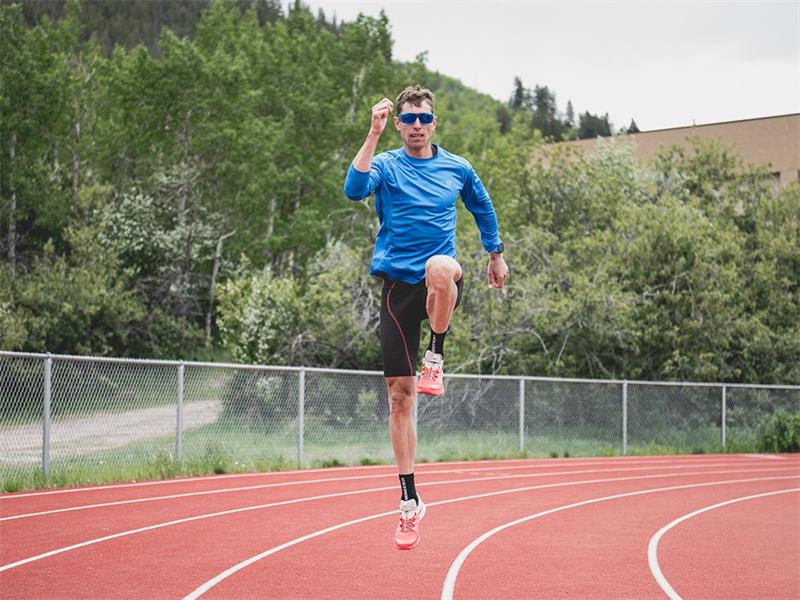Contents
- 1 The Importance of Proper Running Form
- 2 The Ultimate Running Form Exercise: High Knees
- 3 Exercise 2: Butt Kicks
- 4 A Strong Foundation: Single-Leg Deadlifts
- 5 Jumping Lunges: Building Explosive Power for Better Running Form
- 6 The Plank with Hip Dips: A Surprisingly Effective Exercise for Better Running Form
- 7 The Benefits of Side Shuffles for Improving Your Running Form
- 8 Exercise 7: Skipping Drills
- 9 Conclusion
The Importance of Proper Running Form
Running is an incredible form of exercise that has many benefits for the body and mind. It can help you maintain a healthy weight, increase cardiovascular health, and boost your overall mood. However, running can also be tough on your body if you don’t have proper form.
If you’re not careful, running with poor form can lead to injuries like shin splints, knee pain or worse – it can put unnecessary stress on your joints that could result in long-term damage. Proper running form is essential for runners of all levels.
Good technique will help improve your efficiency and reduce the risk of injury while maximizing the benefits associated with running. Correct posture aligns your joints, which helps to distribute impact forces efficiently across the body instead of concentrating on one area.
In addition to reducing injury risk, good form will also help you conserve energy when running long distances – ultimately leading to improved performance and a more enjoyable experience overall. With these 7 exercises that focus on developing proper running technique, you’ll be able to improve your posture and become a better runner in no time!
The Ultimate Running Form Exercise: High Knees
Are you looking for a way to improve your running form and increase your speed? Look no further than high knees, the ultimate exercise for runners. High knees can help you become a stronger, faster runner by improving your balance, coordination, and flexibility.
To perform high knees, start by standing with your feet hip-width apart. Begin jogging in place, bringing your knees up to hip height with each step.
Make sure you’re running on the balls of your feet, not on your heels. Keep your arms bent at a 90-degree angle and pump them back and forth as if you were sprinting.
One of the benefits of high knees is that it helps improve running form by strengthening the muscles in the legs responsible for lifting the knee and driving it forward during each stride. This exercise also teaches runners to engage their core muscles while running, which helps maintain proper posture and prevent injury.
To execute this exercise properly, make sure that you’re staying light on your feet throughout the movement. Resist the urge to pound down hard on each step; instead, focus on bouncing off of each foot quickly and efficiently.
Try starting with five sets of 30 seconds each if you’re new to this exercise before working up to longer durations. If you want to improve your running form and become a more efficient runner overall, add high knees to your workout routine today!
Exercise 2: Butt Kicks
Kick Your Way to Better Running Form
Butt kicks are a simple exercise that can make a big difference in your running form. The movement involves jogging in place while actively bringing your heels up towards your butt.
This motion helps improve the mobility of your hip flexors and strengthens the muscles in your lower body. One of the main benefits of doing butt kicks is that they help to improve the stride length of runners.
By flexing and extending their legs through a larger range of motion, runners can take longer strides, which enables them to cover more ground with each step. This leads to improved running economy, meaning you can run faster with less effort.
Proper Execution is Key
To do butt kicks correctly, begin by jogging in place with your arms relaxed at your sides. Then, focus on bringing one heel up towards your butt while keeping the rest of your body stable. As you bring one heel down to the ground, immediately lift the other heel towards your butt and repeat.
It’s important to keep good posture throughout this exercise by engaging your core muscles and keeping your head up. Also, make sure you are landing on the ball of each foot as you kick back instead of landing flat-footed or on your toes.
To really maximize the benefits of this exercise for improving running form, try incorporating it into a dynamic warm-up routine before going for a run. Doing so will help activate those important hip flexor muscles and get them ready for action during your next run!
A Strong Foundation: Single-Leg Deadlifts
Single-leg deadlifts are a fantastic exercise to improve your running form. This exercise targets your glutes, hamstrings, and core muscles all at once, which are all key areas needed for proper running mechanics. In addition to strengthening these muscles, single-leg deadlifts also work on balance and stability.
To perform a single-leg deadlift, start by standing on one foot with a slight bend in the knee. Keeping your core engaged and back straight, hinge forward at the hips while lifting your opposite leg behind you.
You should feel a stretch in your hamstrings as you lower yourself towards the ground. Once you reach a comfortable depth, push through the heel of your standing foot to return to an upright position.
One of the major benefits of performing single-leg deadlifts is that it helps improve stride length and cadence when running. As you hinge forward and lift your opposite leg behind you, you are essentially mimicking the motion of bringing your leg forward during running.
Training this movement pattern with resistance from the exercise, it can translate into better efficiency and power during runs. It’s important to remember that form is crucial when performing single-leg deadlifts in order to avoid injury and get the most out of the exercise.
Keep your core engaged throughout the entire movement to prevent rounding or arching in your back. Also, be sure to keep your knee slightly bent on both legs throughout the entire movement – locking out either leg can put unnecessary stress on joints and ligaments.
Jumping Lunges: Building Explosive Power for Better Running Form
Jumping lunges are a high-intensity plyometric exercise that can help build explosive power in your legs and improve your running form. To perform jumping lunges, start in a lunge position with one leg forward and the other leg behind you. From there, jump explosively into the air and switch the positions of your legs so that the opposite leg is now forward.
The benefits of jumping lunges for improving running form are numerous. By building explosive power in your legs, you’ll be able to generate more force with each stride, helping you to run faster and more efficiently.
Additionally, jumping lunges can help improve your balance and stability, which are both crucial components of good running form. To execute jumping lunges correctly, it’s important to pay attention to proper technique.
Start by ensuring that both feet land at the same time when you jump into the air. This will help prevent any imbalances or misalignments in your legs that could negatively affect your running form.
Additionally, be sure to keep your knees aligned with your ankles throughout the movement, avoiding any excess twisting or torquing of the joints. Incorporating jumping lunges into your regular workout routine can be an excellent way to improve your overall fitness and running performance.
However, it’s important to start slowly and gradually increase the intensity over time as you build strength and endurance. With consistent practice and proper technique, you’ll soon notice improvements in both your physical fitness levels and overall running form.
The Plank with Hip Dips: A Surprisingly Effective Exercise for Better Running Form
The plank with hip dips is a great exercise to incorporate into any running routine to improve your form. It’s a simple exercise that targets your core and lower body while engaging the muscles required for proper running form. Here’s how to do it:
To start, get into a traditional plank position with your forearms on the ground and your body in a straight line from head to heels. From here, slowly dip one hip towards the ground without letting your torso rotate or hips sag.
Return to the starting position, then repeat on the other side. That’s one rep.
The benefits of this exercise are twofold when it comes to running form: first, it strengthens your core muscles, which are crucial for maintaining good posture while running. Second, it helps improve hip stability and control, which translates directly into better stride mechanics.
When performing this exercise, be sure to maintain proper form throughout each rep. Keep your core tight and engaged throughout the movement and avoid letting your hips sag or rotate during the dips. As you become more comfortable with the exercise, you can increase the difficulty by holding each dip for longer periods of time or adding in a leg lift during each repetition.
Incorporating the plank with hip dips into your regular workout routine can go a long way towards improving running form and reducing the risk of injury. Give it a try next time you hit the gym or go for a run!
The Benefits of Side Shuffles for Improving Your Running Form
Running is a fantastic form of exercise, but it can be tough on your body if you don’t have proper form. One way to improve your running form is by incorporating side shuffles into your workout routine.
This exercise is excellent for strengthening the muscles in your legs and hips that are used while running. It’s also a great cardio workout, which means that it will help increase your endurance and overall fitness level.
Description of Exercise
Side shuffles are a simple yet effective exercise that can be done anywhere with enough space to move laterally. Start by standing with your feet shoulder-width apart and your knees slightly bent.
Step to the side with one foot, then bring the other foot over to meet it. Repeat this motion quickly, moving side-to-side across the room or space you’re in.
Tips for Proper Execution
When doing side shuffles, make sure to keep your knees slightly bent and avoid leaning forward or backward. Also, focus on keeping a good posture throughout the exercise. Keep your chest up and gaze straight ahead, rather than looking down at your feet.
To get the most out of this exercise, try to move as quickly as possible without sacrificing good form. You should feel a burn in your glutes and thighs after just a few repetitions, so start slow and work up to longer sets as you get stronger.
Incorporating side shuffles into your regular workout routine is an easy way to improve your running form while also getting an excellent cardio workout. With proper execution and consistent effort, you’ll soon notice improvements in both endurance and overall fitness level!
Exercise 7: Skipping Drills
Skipping may seem like a basic childhood activity, but it is an effective exercise for improving running form. Skipping drills help to strengthen the muscles responsible for lifting your legs and maintaining proper form. They also improve your ability to push off the ground with power and efficiency.
Benefits of Improving Running Form
The benefits of skipping drills are numerous. They improve ankle and calf strength, which is essential for proper foot strikes and push-off while running. Skipping also promotes coordination between the upper and lower body, which helps to reduce unnecessary movement while running.
Skipping drills can also improve balance, agility, and overall body control. By practicing these movements regularly, you will develop a more efficient stride that conserves energy while increasing your speed.
Tips for Proper Execution
To execute skipping drills properly, begin with a relaxed stance with feet shoulder-width apart. Start hopping lightly on one foot while swinging the opposite arm forward in a natural motion.
As you land back on that same foot, quickly switch to the other foot while swinging that arm forward. Remember to keep your knees slightly bent throughout the exercise and focus on maintaining an upright posture without bending at the waist or arching your back excessively.
Keep your head facing forward throughout each repetition of this exercise. Incorporating skipping drills into your regular workout routine can not only help improve running form but also add some fun variation to your training sessions!
Conclusion
Good running form is essential for any runner, whether you’re a beginner or a seasoned pro. By improving your running form, you can reduce your risk of injury, run more efficiently, and ultimately improve your performance. The 7 exercises outlined in this article are effective ways to improve your running form and make you a better runner.
Incorporating these exercises into your training routine can help you achieve better posture and alignment, increase strength in key muscle groups, and develop better balance and coordination. As with any workout routine, it’s important to start slowly and gradually build up intensity over time.
Remember that good running form is not just about looking good – it’s about feeling good too. When you run with proper form, you’ll feel stronger, more efficient, and more confident than ever before.
So go ahead – lace up those shoes, hit the pavement or the trails, and give these exercises a try. You’re sure to notice a difference in your running form in no time!













